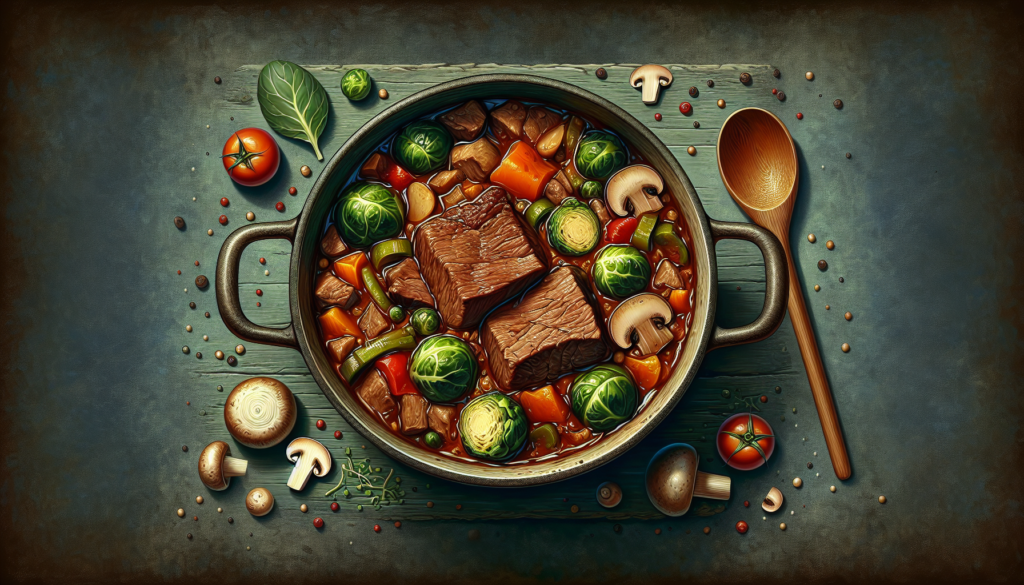Looking for a hearty and delicious meal that fits within your keto diet? Look no further than this Healthy and Delicious Hearty Keto Beef Stew recipe. Designed to cater to individuals following a ketogenic diet, this recipe is packed with health-conscious ingredients that align with the low-carb, high-fat principles of keto. Not only is this stew filled with nutritious goodness, but it’s also easy to prepare, making it accessible to even the most novice of cooks.
Featuring tender beef and a flavorful blend of spices, this comforting stew provides a diverse range of flavors and culinary experiences, ensuring you won’t get bored with your diet. So, whether you’re looking for a satisfying dinner or a satisfying meal planning option, this Hearty Keto Beef Stew has got you covered. Plus, it’s budget-friendly and family-friendly, making it a versatile option for households with varying dietary needs. Get ready to indulge in comfort food made healthy with this delicious keto-friendly stew.
Healthy and Delicious Hearty Keto Beef Stew Recipe

Ingredients
Beef
Beef is the star of this hearty keto beef stew recipe. Choose a high-quality cut of beef, such as chuck roast or stew meat, that will become tender and flavorful when cooked low and slow.
Vegetables
Load up your beef stew with a variety of low-carb vegetables. Some great options include celery, bell peppers, onions, and mushrooms. These vegetables not only add flavor and texture but also provide essential nutrients and fiber.
Broth
To create a flavorful base for your stew, use a rich and savory broth. Opt for a homemade broth or choose a low-sodium store-bought option. Beef broth or bone broth works best in this recipe.
Seasonings
Seasonings are essential for enhancing the taste of your beef stew. Add in some garlic, thyme, rosemary, and bay leaves for a delicious flavor profile. You can also add some salt and pepper to taste.
Optional Additions
If you want to add more variety to your beef stew, consider including optional additions such as diced tomatoes, Worcestershire sauce, or a splash of red wine. These additions can take your stew to the next level of flavor.
Preparation
Preparing the Beef
Before adding the beef to the stew, you’ll want to sear it to lock in all the flavor. Start by cutting the beef into bite-sized pieces and seasoning it with salt and pepper. Heat some oil in a large pot or Dutch oven over medium-high heat. Sear the beef on all sides until it develops a nice brown crust. Once seared, remove the beef from the pot and set it aside.
Sauteeing the Vegetables
After searing the beef, add the vegetables to the pot and sauté them until they start to soften. This will help to enhance their flavors and add depth to your stew. Stir them occasionally to prevent sticking.
Adding the Broth
Once the vegetables are sautéed, add the beef back to the pot and pour in the broth. The broth should cover the beef and vegetables. Bring the mixture to a boil, then reduce the heat to low and cover the pot. Let it simmer for about 1.5 to 2 hours, or until the beef is tender.
Seasoning and Simmering
About halfway through the cooking process, add in the garlic, thyme, rosemary, bay leaves, and any additional seasonings you desire. Stir everything together and let the stew continue to simmer until the flavors meld together and the beef is fork-tender.
Optional Additions
If you’re opting for any of the optional additions, such as diced tomatoes or Worcestershire sauce, add them in during the last 30 minutes of cooking. This will give them enough time to incorporate into the stew.


Nutritional Benefits
High-Quality Protein
Beef is an excellent source of high-quality protein, which is essential for building and repairing body tissues and maintaining muscle mass. By including beef in your stew, you’re getting a protein-packed meal that will keep you satisfied for hours.
Healthy Fats
While beef is often associated with saturated fat, it can also provide a good amount of healthy fats, especially if you choose leaner cuts. The keto diet relies on healthy fats for energy, and incorporating them into your beef stew can help you meet your daily fat intake goals.
Vitamins and Minerals
By adding a variety of vegetables to your beef stew, you’re getting a wide range of vitamins and minerals. Celery, bell peppers, onions, and mushrooms all offer different nutrients that are essential for optimal health. These include vitamin C, vitamin A, potassium, and antioxidants.
Keto-Friendly Adaptations
Low-Carb Vegetables
To keep your beef stew keto-friendly, focus on using low-carb vegetables. Swap out high-carb options like potatoes and carrots for lower-carb alternatives such as cauliflower, turnips, or radishes. These vegetables can mimic the texture and taste of traditional stew ingredients without derailing your keto diet.
Replacing Potatoes
If you’re missing the comforting presence of potatoes in your stew, there are keto-friendly alternatives you can try. Consider using cauliflower or rutabaga instead. These vegetables can be chopped into small pieces and cooked until tender, giving you the same satisfying texture as potatoes without the excess carbs.
Thickening Agents
Traditional beef stew is often thickened with flour or cornstarch, which can add unwanted carbs to your meal. To keep your stew keto-friendly, try using low-carb thickening agents such as xanthan gum or a mixture of almond flour and water. These alternatives will help achieve the desired thickness without compromising your dietary goals.

Tips for Meal Planning
Batch Cooking
Beef stew is an excellent option for batch cooking. Prepare a larger batch and divide it into individual servings that you can freeze or refrigerate for later consumption. This allows you to have ready-to-eat meals throughout the week, saving you time and effort in the kitchen.
Freezing and Reheating
If you plan on freezing your beef stew, make sure to use airtight containers or freezer bags to prevent freezer burn. When reheating, simply thaw in the refrigerator overnight and then heat on the stovetop or in the microwave until warm. This makes it convenient to enjoy a comforting bowl of stew whenever you’re in the mood.
Meal Prep Containers
Invest in meal prep containers to make portioning and storing your beef stew even easier. These containers are designed to keep your food fresh and organized, allowing you to have a well-rounded meal ready to grab and go. They are also stackable and dishwasher-safe, making cleanup a breeze.
Delicious Serving Ideas
Cauliflower Rice
If you’re looking for a low-carb alternative to serve your beef stew over, cauliflower rice is a fantastic option. Simply pulse cauliflower florets in a food processor until they reach a rice-like consistency. Cook the cauliflower rice in a skillet with some oil until tender. Serve your beef stew over the cauliflower rice for a satisfying and complete meal.
Keto Bread
Another tasty serving idea for your beef stew is keto bread. There are many recipes available that use almond flour, coconut flour, or a combination of both to create a low-carb, high-fat bread that pairs perfectly with a hearty stew. Toast the keto bread and enjoy it on the side or soak it in the stew for added flavor and texture.
Side Salad
If you’re looking to add some freshness and crunch to your meal, serve your beef stew with a side salad. Choose low-carb leafy greens such as spinach or kale and top them with cheese, nuts, and a keto-friendly dressing. The combination of the warm stew and the refreshing salad creates a well-balanced and satisfying meal.

Budget-Friendly Tips
Choosing Affordable Cuts of Beef
To keep your beef stew budget-friendly, opt for affordable cuts of beef. These cuts tend to be tougher, but when cooked low and slow in the stew, they become tender and flavorful. Choose cuts such as chuck roast, stew meat, or beef shanks, which are often more affordable than premium cuts.
In-Season Vegetables
Another way to save money on your beef stew is to use in-season vegetables. Seasonal vegetables are often more abundant and therefore more affordable. Take advantage of the local produce available during different times of the year to keep your stew fresh and cost-effective.
Homemade Broth
Making your own broth can be a cost-effective option compared to store-bought varieties. Save the bones from roast dinners or buy inexpensive beef bones to make a flavorful broth at home. Simmer the bones with water, vegetables, and seasonings to create a rich and nourishing base for your beef stew.
Family-Friendly Modifications
Kid-Friendly Seasonings
If you’re serving beef stew to a family with children, consider adjusting the seasonings to make it more kid-friendly. Reduce the amount of herbs and spices or omit them altogether to create a milder flavor profile. You can always offer additional seasonings at the table for adults to customize their stew.
Serving with Non-Keto Sides
If your family includes individuals who aren’t following a keto diet, you can still make the beef stew family-friendly by serving it with non-keto sides. Offer options like dinner rolls or mashed potatoes alongside the stew for those who prefer a more traditional accompaniment. This way, everyone can enjoy a satisfying and comforting meal together.
Hidden Vegetables
If you have picky eaters in your family who are reluctant to eat their vegetables, consider blending or finely chopping them before adding them to the stew. This will help disguise the vegetables while still providing their nutritional benefits. The flavors will also meld together, making it less noticeable for those who are hesitant to try new foods.

Global Cuisine Inspiration
Mexican-Inspired Beef Stew
For a Mexican twist on beef stew, add some spices like cumin, chili powder, and paprika to your stew. You can also include ingredients like diced tomatoes, jalapenos, and cilantro for added flavor. Serve it over cauliflower rice or with a side of keto-friendly tortillas for a satisfying meal with a kick.
Asian-Inspired Beef Stew
To give your beef stew an Asian-inspired flavor, incorporate ingredients like ginger, soy sauce, and star anise. You can also add in some bok choy, snow peas, or bean sprouts for a refreshing crunch. Serve the stew over cauliflower rice or konjac noodles for an authentic Asian experience.
Italian-Inspired Beef Stew
For an Italian twist, add some Italian herbs like oregano, basil, and thyme to your beef stew. You can also include ingredients like diced tomatoes, garlic, and mushrooms for a robust and comforting flavor. Serve the stew over zucchini noodles or with a side of keto garlic bread for a taste of Italy.
Incorporating Superfoods
Adding Kale or Spinach
To boost the nutritional value of your beef stew, consider adding superfood greens like kale or spinach. These leafy greens are packed with vitamins, minerals, and antioxidants. Simply chop them and add them to the stew during the last few minutes of cooking to retain their vibrant color and nutrients.
Including Turmeric
Turmeric is a potent spice known for its anti-inflammatory properties. Adding a teaspoon or two of turmeric to your beef stew can enhance its health benefits and give it a warm, earthy flavor. Turmeric pairs well with other seasonings like cumin and ginger, enriching the overall taste of the stew.
Using Coconut Oil
Swap out traditional cooking oils for coconut oil when making your beef stew. Coconut oil contains medium-chain triglycerides (MCTs), which can contribute to increased energy levels and help support ketosis. Its subtle coconut flavor adds a tropical twist to your stew while providing these health benefits.
By following these tips and adding your own creative touch, you can make a delicious and nutritious hearty keto beef stew. Whether you’re cooking for yourself, your family, or hosting a gathering, this recipe offers comfort food made healthy. Enjoy the flavors and indulge in a satisfying meal while staying on track with your ketogenic lifestyle.


